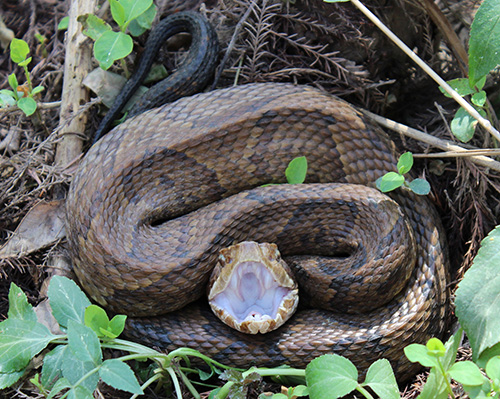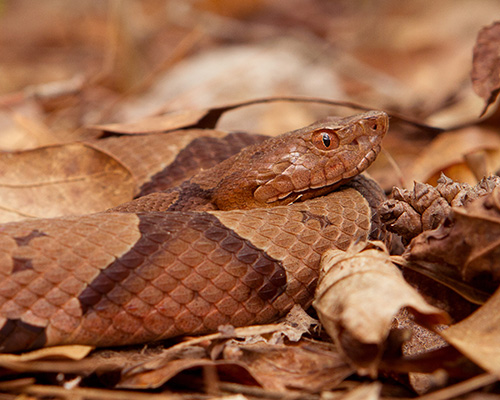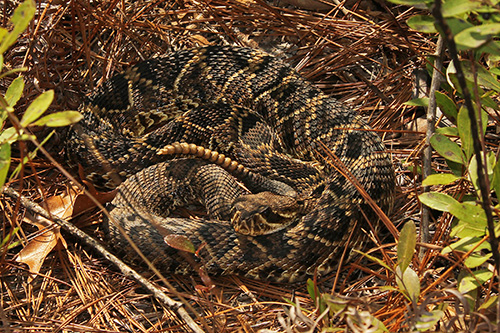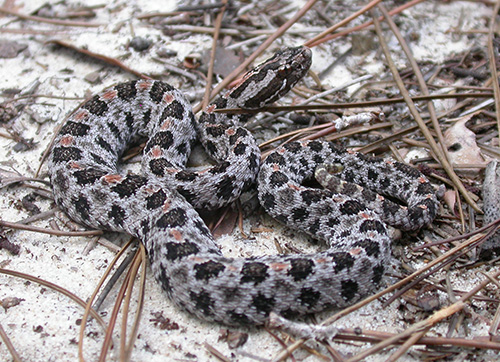Feared animals actually serve a vital role in nature
Most of us have an innate fear of snakes. Bring them up in a group discussion and you’re likely to hear at least one person say, “The only good snake is a dead snake.”
But that’s just not true, wildlife biologists say. Snakes are carnivorous, meaning they eat other smaller animals. Most readily eat rodents like mice and rats, while others prey on insects. If not for snakes, many areas would be overrun with these pests. Snakes also help farmers by controlling rodent populations in seed or grain storage areas, barns, gardens, fields and houses.
Alabama is home to more than 40 species of snakes, but ac-cording to the state Department of Conservation and Natural Resources, only six are venomous. Five of the six belong to a group termed the pit vipers; this includes the cottonmouth, copperhead and three rattlesnakes (timber, eastern diamondback and pygmy). The sixth is the reclusive coral snake.
Snakes by their nature are secretive, so their appearance on the family farm or yard will likely send the homeowner running for the house. But unless they are provoked, snakes in North America will not attack. They usually have to be picked up, cornered, stepped on or harmed in some way to provoke a strike; a snake’s first response is almost always to flee rather than bite.
The advice from the Conservation Department: Don’t be so quick to kill every snake that’s encountered. Most snakebites are the result of people trying to catch or kill a snake. If you encounter a venomous snake in the wild, just leave it alone. If it is in your yard, consider calling a professional wildlife damage control agent and have it captured and removed before killing it needlessly.
Still, for anyone who spends a good deal of time outdoors, it’s worth learning about the six venomous snakes and their markings.

COTTONMOUTH:
These are common in Alabama, particularly around any body of water, including swamp-lands. The name is derived from its white inner mouth, which is oft en exposed when the snake is disturbed. It tends to stand its ground more so than other snakes.

COPPERHEAD:
The cottonmouth’s up-land counterpart. Dark brown bands on a coppery lighter background that resemble an hourglass pattern make this snake especially hard to detect in the forest leaf. More are bitten by this snake in the Southeast than any other venomous snake.

EASTERN DIAMONDBACK RATTLESNAKE:
The largest rattlesnake in Alabama prefers drier sites such as coastal sandy pine forests. This hefty snake has dark brown to black diamonds along the length of its back. An ambush predator, it often sits coiled and motion-less for hours while it waits for small rodents.

CORAL SNAKE:
Brightly colored bands of black, yellow and red are its signature; it resembles other similarly colored snakes, but old sayings, such as “red on yellow will kill a fellow” and “red on black, friend of Jack” help distinguish it. Bites from this snake are rare and usually associated with someone trying to handle the snake.

PYGMY RATTLESNAKE:
The smallest rattlesnake is quick-tempered and is quick to coil and rattle, though it’s hardly perceptible. Often called a “ground rattler,” it has a light gray back-ground with dark brown to orange blotches along the back.

TIMBER (CANEBRAKE) RATTLESNAKE:
Varies in color from gray to brown, with dark brown V-shaped bands or chevrons evenly spaced down the length of its body. Its col-oration makes it also hard to detect. Usually occupies similar areas to that of the copperhead, but is found in areas that are a little wetter.
IF TROUBLE STRIKES:
Snakebites are uncommon, but can be deadly if not treated quickly. For those who spend a good deal of time outdoors, it’s worth remembering these initial first aid tips, from Children’s of Alabama and the Conservation Department: Seek medical attention immediately
- Don’t use a tourniquet
- Don’t use ice or a cold compress
- Don’t try to cut into a bite with a knife or razor
- Remove rings and constrictive items from arms and hands
- Wrap wound with compression bandages. Go about four inches above the wound, wrapping as you would a sprained ankle
- Immobilize the extremity
- Keep patient calm and warm
- Don’t try to suck the venom out by mouth
- Don’t raise the site of the bite above heart level
- Don’t drink caffeine or alcohol




